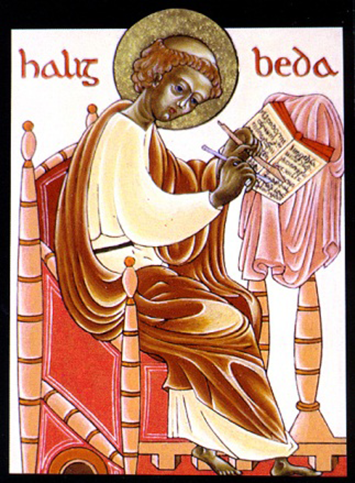St. Bede the Venerable
Troparion of St. Bede the Venerable
Tone VIII
Throughout the dark years of thy times, O Bede, thou didst water the English lands and all the West with outpourings of grace; and like a skilled sower thou didst cast the seed of divine knowledge far and wide over the fields of thy Master, where, springing forth, it hath borne fruit for Him an hundredfold. Wherefore, having thus acquired boldness before Him, O venerable one, pray thou unceasingly that our souls be saved.

Icon of St. Bede the Venerable
BEDE the VENERABLE, St. Bede the Venerable (also called The Venerable Bede), was an Anglo-Saxon monk, biblical exegete, hagiographer, and historian. He was the foremost and most influential scholar of Anglo-Saxon England. St. Bede was famous for his prodigious learning, and even more so for the holiness of his life. In the early Middle Ages, it was common for families to dedicate a child to a monastery at a young age and place him there to be raised and educated. So, at the age of seven, St. Bede’s family placed him at the monastery of SS. Peter and Paul at Wearmouth-Jarrow under St. Benedict Biscop (12th January). He was ordained to the deaconate at the age of 19 and to the priesthood by St. John of Beverley (7th May) at the age of 30. Aside from brief excursions to Lindisfarne and York, Bede spent the remainder of his life at Jarrow, devoting himself to prayer and scholarship, reading, teaching, and Scriptural exegesis.
Although his best-known work is Historia Ecclesiastica Gentis Anglorum (The Ecclesiastical History of the English People), which gained him the title “The Father of English History”, St. Bede wrote on many other topics, from music and musical metrics to scripture commentaries. It is thought that during St. Bede’s time the library at Wearmouth-Jarrow was one of the largest in England, and it is clear from his work that St. Bede had an in-depth knowledge of all the library contained. His proficiency in patristics, as well as his knowledge of the great classical writers was unrivalled. St. Bede’s writings provide rare insight into the religious and secular life of early Britain.
Better a stupid and unlettered brother who, working the good things he knows, merits life in Heaven than one who though being distinguished for his learning in the Scriptures, or even holding the place of a doctor, lacks the bread of love.”
— St. Bede the Venerable
In addition to a command of Latin, St. Bede was proficient in Greek, and knew a little Hebrew, and he was a skilful storyteller. St. Bede established the practice of dividing the pre-Christian and Christian eras into B.C. and A.D. He invented footnoting and not only recalculated the age of the earth, but wrote that it was “round like a ball”. His re-edited Bible, the first to contain the entire Bible in one volume, was used by the Roman Catholic Church until 1966. His exegesis and translations made the scriptures accessible to the Anglo-Saxon people of his era in their own language. De Temporum Ratione, written by St. Bede in 725, which survives in some 250 manuscripts, proved to be the most widely studied computistical manual of the Middle Ages. It was an expansion of his earlier De Temporibus, which he had written to explain to his students the principles for the calculation of the date of Easter according to the Roman usage adopted by the Synod of Whitby. He made his mark as a hagiographer with his two Lives of St. Cuthbert of Lindisfarne (20th March) — one in verse and a later edition in prose — which also established the cult of St. Cuthbert throughout Europe. St. Bede accomplished all of this whilst teaching all day, spending a good part of the night in prayer, and fulfilling his monastic obediences. St. Bede also had a great love for the services of the Church, and believed that since the angels were present at the services, he should always be there as well, asking “What if they do not find me among the brethren when they assemble? Will they not say, ‘Where is Bede?’”
St. Bede was dictating an Anglo-Saxon translation of the Gospel of St. John, as well as a book of extracts from the writings of St. Isidore of Seville (4th April) when his breathing became laboured, and his feet began to swell. The student taking the dictation told St. Bede “Dear Master, there is one sentence left unfinished”. Bede said, “Very well, write it down”, then the young monk said, “It is finished now”. To which St. Bede replied, “You have spoken truly, it is well finished”. St. Bede then asked that his head be raised so that he could see the church where he had always prayed, and after saying “Gloria Patri et Filio et Spiritui Sancto”, fell asleep in the Lord. He was approximately sixty years of age.
There is no agreement on when or why St. Bede received the title “Venerable” other than it was soon after his death. Originally buried at Jarrow, his relics were later translated to a raised tomb at one end of the cathedral in Durham, England. St. Bede is also the only Englishman to appear in Dante’s Paradise (Paradiso X.130); he is mentioned among theologians and doctors of the church in the same canto as St. Isidore of Seville (4th April).
"The Church in The British Isles will only begin to grow when She begins to again venerate Her own Saints"
(Saint Arsenios of Paros †1877)
